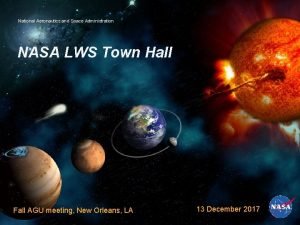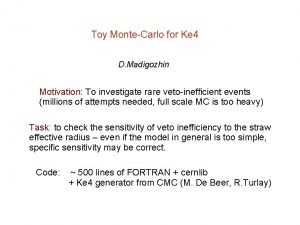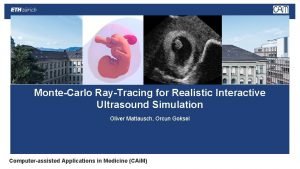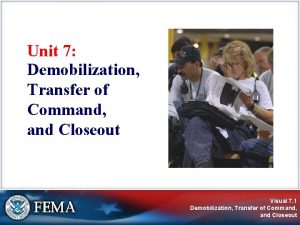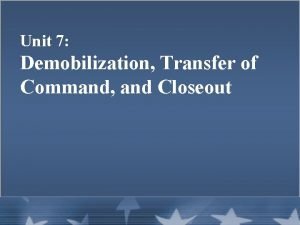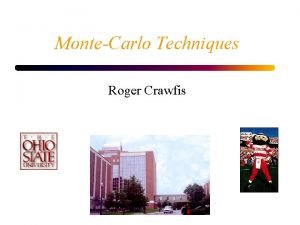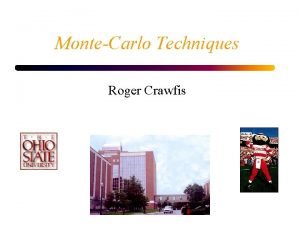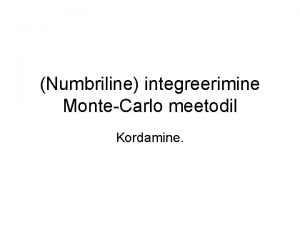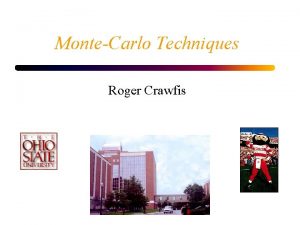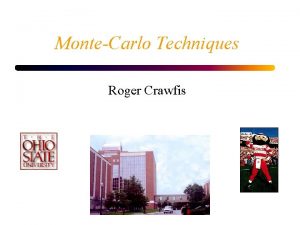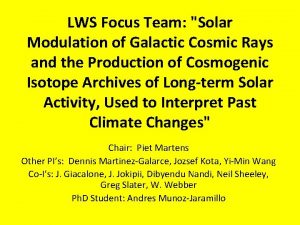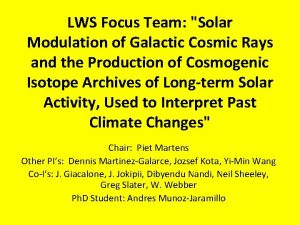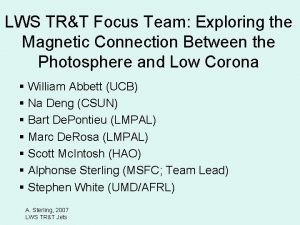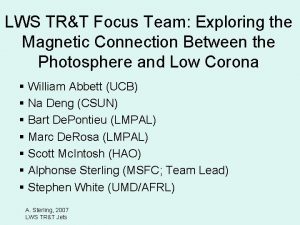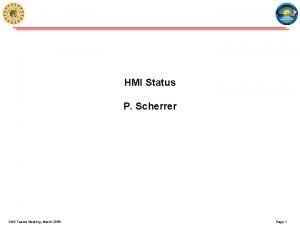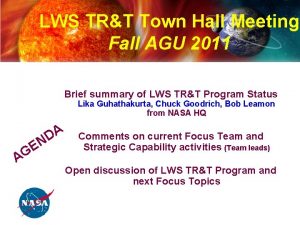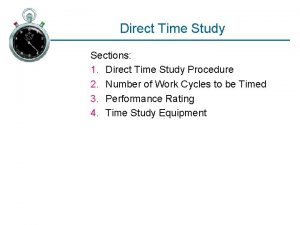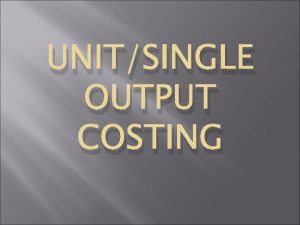LWS Team meeting Using Direct MonteCarlo to study


























- Slides: 26

LWS Team meeting Using Direct Monte-Carlo to study transport Gang Li Sep. 16 th, 2008

Motivation In using the focused transport equation to model specific event, one often assume that r or are r-independent => no radial dependence for Duu. No physical reason, probably for simplicity (easier coding for finite difference method). Direct Monte-Carlo is more intuitive, but computationally more demanding in the past. Not a problem any more. Want to explore the effect of an r-dependent Duu on particle transport --- time intensity profile, spectra, etc. Initially, has electrons in mind (injection delay between ions and electrons).

Origin of pitch angle scattering In quasi-linear theory, pitch angle scattering is caused by charged particle interacting with turbulent magnetic field. (Jokipii, 1966) The change of pitch angle is diffusive, often described by a random walk process, and the rate of change is proportional to the power of B. deterministic characteristic stochastic “scattering”–random walk

Solving the transport equation 1 a) Finite difference method (eg. Ruffolo et al 1995) 1 b) Finite difference method, add a twist of Monte-carlo in deciding . (Earl 1976, 1994) 2) Using a stochastic approach, f => f/B. Still solving f. (e. g. Qin et al. 2005) 3) Direct Monte-Carlo simulation => equations describing single particle motion. (Li et al 2008).

Fokker Planck’s coefficient D QLT limitation: slab geometry, magnetostatic. Dynamical Turbulence Bieber et al. (1994) Damping model Random sweeping model

Fokker Planck’s coefficient D (cont. ) Bieber et al. (1994) (kz - / v) (Cauchy form) (Gaussian form)

Turbulence in the solar wind Injection scales ~k-1 Injection scales Inertial range k-5/3 = energy transfer rate Inertial range Dissipation scales fc Dissipation scales Bruno et al. , 1985, q ~ -1 Leamon et al, 1999] Vasquez et al. 2007 q~ -2. 1 - -2. 5

Turbulence in the solar wind (2) Komogorov has -5/3, which is hard to distinguish from -1. 5. In different ranges, energy containing, inertial and dissipation range, q can vary a lot. consider different cases, q = 1. 5, 1. 666, 2. 5 and vary four cases. Input: 1 AU observations of the power spectrum (d. B^2) and correlation length and some r dependence of interplanetary turbulence. Output: time intensity profiles at 3 rs r = 0. 5, 1. 0, and 1. 5 AU. spectrum. anisotropy analysis [ not accomplished yet. ]

if only examine u dependence, we obtain. This, however, ignores r-dependence completely. The form of P (power spectrum), including dissipation range is: C and lambda_c in the above are the two parameters decide the power. Relate them to observed quantity through,

Use the same observed quantities, but different q value (since it is hard to tell the difference between 1. 5 and 1. 666) to drive the simulation. Two energies: K = 10 Me. V/nucleon and 0. 5 Me. V/nucleon, for four species: proton, Q/A = 1; Helium Q/A = 2/4, Oxygen Q/A =6/16; Iron Q/A =14/56. Simulation assumes a delta-injection in time. Plot derived quantity lambda. Plot time-intensity profiles. goal is to 1) understanding different pieces in the transort equation. 2) find similarities (resemblance) between simulation and observations ==> guidance for future work. [more realistic injection profiles, etc. ]





In this work, we keep Duu (mfp) unchanged, i. e. we use Duu with its value at (r=1 AU) throughout the simulation although previous figures show Duu change with r in a WKB approximation.

Time intensity profile at r = 1 AU

Time intensity profile at r = 1 AU

Time intensities at r = 0. 5 AU

Time intensities at r = 0. 5 AU

Time intensities at r = 1. 5 AU

Time intensities at r = 1. 5 AU

R-dependent Duu Blue -> proton red -> Helium blk -> iron




confident with the code. Time intensity is very sensitive to r. Helios, Solar Orbiter, Solar Probe. If Duu has no r dependence --- time intensity scales well. R-dependent Duu resembles an extended injection.
 Nasa lws
Nasa lws Montecarlo
Montecarlo Montecarlo
Montecarlo Montecarlo
Montecarlo Metodo montecarlo esempio
Metodo montecarlo esempio Montecarlo
Montecarlo Today meeting or today's meeting
Today meeting or today's meeting Proposal kickoff meeting agenda
Proposal kickoff meeting agenda What is meeting and types of meeting
What is meeting and types of meeting Types of meeting
Types of meeting Cft meeting questions
Cft meeting questions Tims meeting
Tims meeting Team around family
Team around family Team meeting objectives
Team meeting objectives Team review meeting
Team review meeting What replaced the common assessment framework in 2014
What replaced the common assessment framework in 2014 Demobilization planning helps to
Demobilization planning helps to A team closeout meeting is needed when
A team closeout meeting is needed when Team meeting presentation template
Team meeting presentation template Team meeting objectives
Team meeting objectives Team spirit becomes team infatuation
Team spirit becomes team infatuation Team spirit becomes team infatuation
Team spirit becomes team infatuation The white team cheers for the blue team, just like
The white team cheers for the blue team, just like Using system using system.collections.generic
Using system using system.collections.generic Accumulator ac
Accumulator ac What is a direct comparison
What is a direct comparison What figure of speech that has a direct comparison
What figure of speech that has a direct comparison
